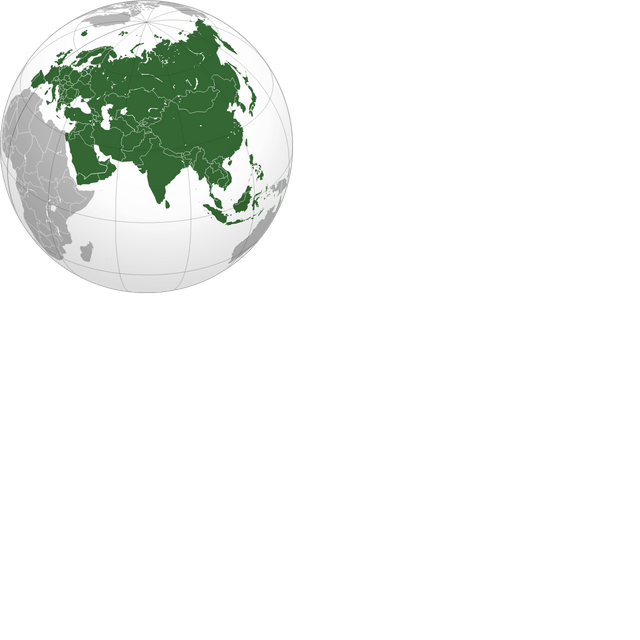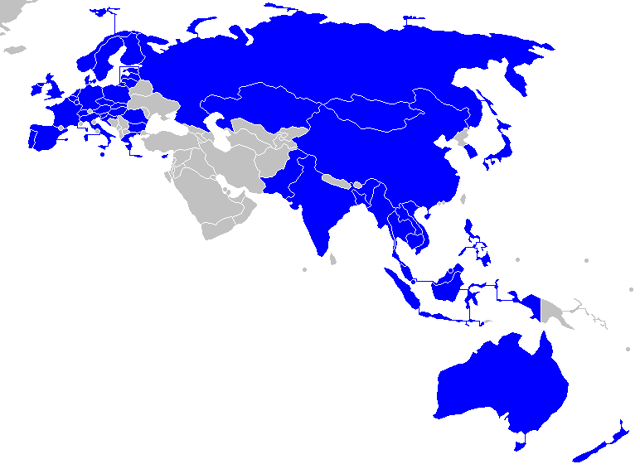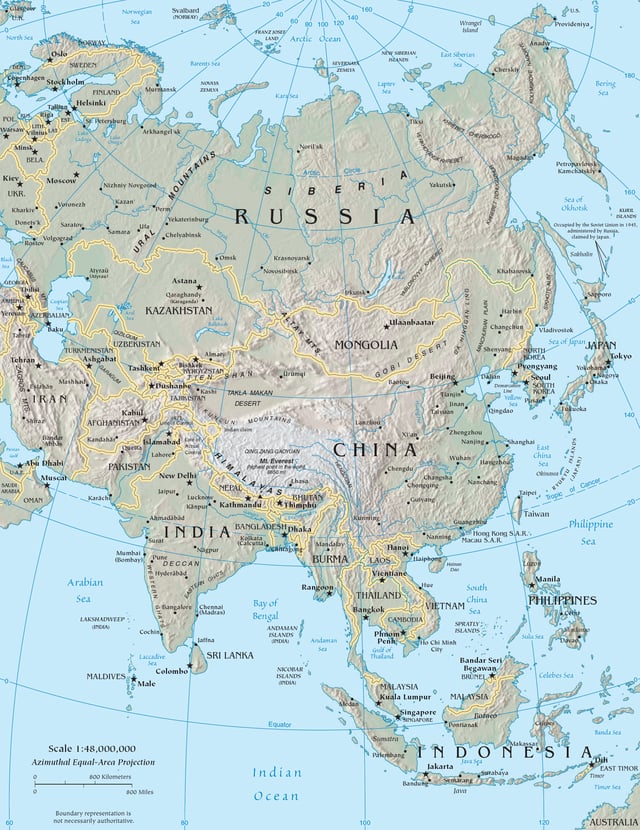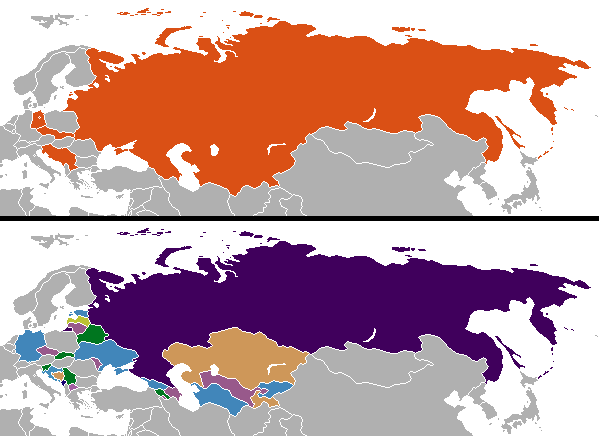Eurasia

Eurasia
Eurasia /jʊəˈreɪʒə/ is the largest continent on Earth, comprising all of Europe and Asia.[3][4] Located primarily in the Northern and Eastern Hemispheres, it is bordered by the Atlantic Ocean to the west, the Pacific Ocean to the east, the Arctic Ocean to the north, and by Africa, the Mediterranean Sea, and the Indian Ocean to the south.[5] The division between Europe and Asia as two different continents is a historical social construct, with no clear physical separation between them; thus, in some parts of the world, Eurasia is recognized as the largest of the six, five, or even four continents on Earth.[4] In geology, Eurasia is often considered as a single rigid megablock. However, the rigidity of Eurasia is debated based on paleomagnetic data.[6][7]
Eurasia covers around 55,000,000 square kilometres (21,000,000 sq mi), or around 36.2% of the Earth's total land area. The landmass contains well over 5 billion people, equating to approximately 70% of the human population. Humans first settled in Eurasia between 60,000 and 125,000 years ago. Some major islands, including Great Britain, Iceland, and Ireland, and those of Japan, the Philippines and Indonesia, are often included under the popular definition of Eurasia, in spite of being separate from the contiguous landmass.
Physiographically, Eurasia is a single continent.[4] The concepts of Europe and Asia as distinct continents date back to antiquity and their borders are geologically arbitrary. In ancient times the Black Sea and the Sea of Marmara, along with their associated straits, were seen as separating the continents, but today the Ural and Caucasus ranges are more seen as the main delimiters between the two. Eurasia is connected to Africa at the Suez Canal, and Eurasia is sometimes combined with Africa to make the largest contiguous landmass on Earth called Afro-Eurasia.[8] Due to the vast landmass and differences in latitude, Eurasia exhibits all types of climate under the Köppen classification, including the harshest types of hot and cold temperatures, high and low precipitation and various types of ecosystems.
History

The boundary of 13th century Mongol Empire and location of today's Mongols in modern Mongolia, Russia and China.
Eurasia formed 375 to 325 million years ago with the merging of Siberia, Kazakhstania, and Baltica, which was joined to Laurentia, now North America, to form Euramerica. Chinese cratons collided with Siberia's southern coast.
Eurasia has been the host of many ancient civilizations, including those based in Mesopotamia, the Indus Valley and China. In the Axial Age (mid-first millennium BC), a continuous belt of civilizations stretched through the Eurasian subtropical zone from the Atlantic to the Pacific. This belt became the mainstream of world history for two millennia.
Geopolitics

Single markets in European and post Soviet countries; European Economic Area and Common Economic Space
Originally, “Eurasia” is a geographical notion: in this sense, it is simply the biggest continent; the combined landmass of Europe and Asia. However, geopolitically, the word has several different meanings, reflecting the specific geopolitical interests of each nation.[9] “Eurasia” is one of the most important geopolitical concepts; as Zbigniew Brzezinski observed:
“... how America "manages" Eurasia is critical. A power that dominates “Eurasia” would control two of the world’s three most advanced and economically productive regions. A mere glance at the map also suggests that control “Eurasia” would almost automatically entail Africa’s subordination, rendering the Western Hemisphere and Oceania geopolitically peripheral to the world’s central continent. About 75 per cent of the world’s people live in “Eurasia”, and most of the world’s physical wealth is there as well, both in its enterprises and underneath its soil. “Eurasia” accounts for about three-fourths of the world’s known energy resources.”[10]
The Russian concept of “Eurasia” corresponded initially more or less to the land area of Imperial Russia in 1914, including parts of Eastern Europe.[11] One of Russia's main geopolitical interests lies in ever closer integration with those countries that it considers part of “Eurasia.”[12] This concept is further integrated with communist eschatology by author Alexander Dugin as the guiding principle of "self-sufficiency of a large space" during expansion.[13]
The term Eurasia gained geopolitical reputation as one of the three superstates in 1984, [14] George Orwell's[15] novel where constant surveillance and propaganda are strategic elements (introduced as reflexive antagonists) of the heterogeneous dispositif such metapolitical constructs use in order to control and exercise power.[16]
Regional organisations and alliances

ASEM Partners
Across Eurasia, several single markets have emerged including the Eurasian Economic Space, European Single Market, ASEAN Economic Community and the Gulf Cooperation Council. There are also several international organizations and initiatives which seek to promote integration throughout Eurasia, including:
Asia-Europe Meeting
Every two years since 1996 a meeting of most Asian and European countries is organised as the Asia–Europe Meeting (ASEM).
Commonwealth of Independent States

Member States of the Eurasian Economic Union Observer states Other candidate states
The Commonwealth of Independent States (CIS) is a political and economic association of 10 post-Soviet republics in Eurasia formed following the dissolution of the Soviet Union. It has an estimated population of 239,796,010. The CIS encourages cooperation in economical, political and military affairs and has certain powers to coordinate trade, finance, lawmaking and security. In addition, six members of the CIS have joined the Collective Security Treaty Organization, an intergovernmental military alliance that was founded in 1992.
Eurasian Union
Similar in concept to the European Union, the Eurasian Union is an economic union established in 2015 including Russia, Armenia, Belarus, Kazakhstan, Moldova and some of their neighbors, headquartered in Moscow, Russia and Minsk, Belarus. The union promotes economic integration among members and is theoretically open to enlargement of any country in Europe or Asia.
Federation of Euro-Asian Stock Exchanges
The Federation of Euro-Asian Stock Exchanges (FEAS) is an international organization comprising the main stock exchanges in Eastern Europe, the Middle East and Central Asia. The purpose of the Federation is to contribute to the cooperation, development, support and promotion of capital markets in the Eurasian region.
Russia-EU Common Spaces
The Russia - EU Four Common Spaces Initiative, is a joint European Union and Russian agreement with the aim to closer integrate Russia and the EU, remove barriers to trade and investment and promote reforms and competitiveness. In 2010, Russian Prime Minister Vladimir Putin called for common economic space, free-trade area or more advanced economic integration, stretching from Lisbon to Vladivostok. However, no significant progress was made and the project was put on hold after Russia-EU relations deteriorated following the Ukrainian crisis in 2013.
Shanghai Cooperation Organisation
The Shanghai Cooperation Organisation is a Eurasian political, economic and security alliance, the creation of which was announced on 15 June 2001 in Shanghai, China. It is the largest regional organisation in the world in terms of geographical coverage and population, covering three-fifths of the Eurasian continent and nearly half of the human population.
Use of term
History of the Europe–Asia division

Physical map of Asia
In ancient times, the Greeks classified Europe (derived from the mythological Phoenician princess Europa) and Asia (derived from Asia, a woman in Greek mythology) as separate "lands". Where to draw the dividing line between the two regions is still a matter of discussion. Especially whether the Kuma-Manych Depression or the Caucasus Mountains form the southeast boundary is disputed, since Mount Elbrus would be part of Europe in the latter case, making it (and not Mont Blanc) Europe's highest mountain. Most accepted is probably the boundary as defined by Philip Johan von Strahlenberg in the 18th century. He defined the dividing line along the Aegean Sea, Dardanelles, Sea of Marmara, Bosporus, Black Sea, Kuma–Manych Depression, Caspian Sea, Ural River, and Ural Mountains.
Geography
In modern usage, the term "Eurasian" is a demonym usually meaning "of or relating to Eurasia" or "a native or inhabitant of Eurasia".[17] It is also used to describe people of combined "Asian" and "European" descent.
Located primarily in the eastern and northern hemispheres, Eurasia is considered a supercontinent, part of the supercontinent of Afro-Eurasia or simply a continent in its own right.[18] In plate tectonics, the Eurasian Plate includes Europe and most of Asia but not the Indian subcontinent, the Arabian Peninsula or the area of the Russian Far East east of the Chersky Range.
From the point of view of history and culture, Eurasia can be loosely subdivided into Western and Eastern Eurasia.[19]
Soviet states after decentralization

Changes in national boundaries after the collapse of the Eastern Bloc
Nineteenth-century Russian philosopher Nikolai Danilevsky defined Eurasia as an entity separate from Europe and Asia, bounded by the Himalayas, the Caucasus, the Alps, the Arctic, the Pacific, the Atlantic, the Mediterranean, the Black Sea and the Caspian Sea, a definition that has been influential in Russia and other parts of the former Soviet Union.[20] Nowadays, partly inspired by this usage, the term Eurasia is sometimes used to refer to the post-Soviet space – in particular Russia, the Central Asian republics, and the Transcaucasian republics – and sometimes also adjacent regions such as Turkey, Mongolia, Afghanistan and Xinjiang.
The word "Eurasia" is often used in Kazakhstan to describe its location. Numerous Kazakh institutions have the term in their names, like the L. N. Gumilev Eurasian National University (Kazakh: Л. Н. Гумилёв атындағы Еуразия Ұлттық университеті; Russian: Евразийский Национальный университет имени Л. Н. Гумилёва)[21] (Lev Gumilev's Eurasianism ideas having been popularized in Kazakhstan by Olzhas Suleimenov), the Eurasian Media Forum,[22] the Eurasian Cultural Foundation (Russian: Евразийский фонд культуры), the Eurasian Development Bank (Russian: Евразийский банк развития),[23] and the Eurasian Bank.[24] In 2007 Kazakhstan's President, Nursultan Nazarbayev, proposed building a "Eurasia Canal" to connect the Caspian Sea and the Black Sea via Russia's Kuma-Manych Depression in order to provide Kazakhstan and other Caspian-basin countries with a more efficient path to the ocean than the existing Volga-Don Canal.[25]
This usage is comparable to how Americans use "Western Hemisphere" to describe concepts and organizations dealing with the Americas (e.g., Council on Hemispheric Affairs, Western Hemisphere Institute for Security Cooperation).
See also
Asia-Europe Foundation
Asia–Europe Meeting
Afro-Eurasia
Borders of the continents
Council of Europe
Community for Democracy and Rights of Nations
Eastern Partnership
Eurasia (Nineteen Eighty-Four)
Eurasian (disambiguation)
Eurasian Economic Community
Eurasia Tunnel
Eurasian Union
Eurasianism
European Union
Euronest Parliamentary Assembly
Federation of Euro-Asian Stock Exchanges
Intermediate Region
Laurasia, a geological supercontinent joining Eurasia and North America.
List of Eurasian countries by population
List of supercontinents
Marmaray, railway tunnel links the Europe to Asia.
Neo-Eurasianism
Organization of the Black Sea Economic Cooperation
Organization for Security and Co-operation in Europe
Palearctic
Shanghai Cooperation Organisation
Steppe Route
Turkish Straits
Vega expedition, the first voyage to circumnavigate Eurasia
United States of Eurasia
Further reading
The Dawn of Eurasia: On the Trail of the New World Order by Bruno Maçães, Publisher: Allen Lane
D. Lane, V. Samokhvalov, The Eurasian Project and Europe Regional Discontinuities and Geopolitics, Palgrave: Basingstoke (2015)
V. Samokhvalov, The new Eurasia: post-Soviet space between Russia, Europe and China, European Politics and Society, Volume 17, 2016 – Issue sup1: The Eurasian Project in Global Perspective (Journal homepage)
